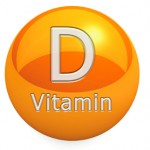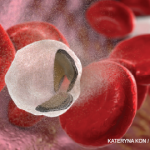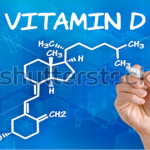Vitamin D Deficiency
In recent years, there has been a great focus on preventing skin cancer. There also has been much media attention on using sunscreen with a minimum sun protection factor (SPF) of 15 to avoid both ultraviolet (UV) A and B radiation. Because they have reduced exposure to this radiation, a key element in the production of vitamin D, many people have become vitamin D deficient.1 Overt vitamin D deficiency is rare; rheumatologists primarily see subclinical vitamin D deficiency and its effect on osteoporosis.
Mechanisms and Clinical Manifestations
In children, vitamin D deficiency manifests as rickets with bowing of the legs. In adults, vitamin D deficiency can present as osteomalacia due to defective skeletal mineralization, which increases the risk of osteopenia, osteoporosis, and hip fractures.2 Often, vitamin D deficiency or insufficiency go undetected. Consensus on the vitamin D “level” considered to be deficient is controversial.2,3
The main role of vitamin D is to regulate calcium homeostasis and optimal skeletal health (increased muscle performance and balance and decreased risk of falls).4 Vitamin D usually refers to vitamin D2 (ergocalciferol) or D3 (cholecalciferol). There are very few foods that contain natural vitamin D. Examples of some vitamin D–containing foods are oily fish (e.g., salmon, mackerel, blue fish, herring, sardines), shiitake mushrooms, and egg yolks. Since very few foods naturally contain vitamin D, many foods are fortified with it. Some examples of fortified food include milk, orange juice, yogurt, butter, margarine, infant formulas, cheeses, and breakfast cereals. Vitamin D obtained from sun exposure, food, and supplements is biologically inert.
In order for vitamin D to be activated and exert its biological effect, it must undergo two hydroxylations. The first hydroxylation takes place in the liver via the hepatic microsomal and/or mitochondrial enzyme vitamin D 25-hydroxylase, converting vitamin D to 25(OH)D (also known as calcidiol). The second hydroxylation (mainly in the kidney) forms the physiologically active 1,25-dihydroxyvitamin D [1,25(OH)2D] (also known as calcitriol).
Development Pipeline
Lodotra 5 mg once daily met the primary endpoint at 12 weeks in the Circadian Administration of Prednisone in Rheumatoid Arthritis-2 (CAPRA-2) trial. Lodotra is a novel single-pulse, delayed-release low-dose prednisone tablet. Lodotra-treated patients showed an ACR-20 response of 49% versus placebo (29%).8
An abuse-resistant form of oxycodone (Remoxy) is undergoing Food and Drug Administration (FDA) review. The manufacturer anticipates FDA approval by mid-2010.9
Risk Factors and Diagnosis
Patients with rheumatoid arthritis, ankylosing spondylitis, and lupus are at an increased risk of developing osteoporosis and fractures.4 Other conditions that can place patients at an increased risk for these bone disorders include adrenal insufficiency, end-stage renal disease, alcoholism, or depression. Certain medications, that, depending on dose, may predispose these patients to fractures include heparin, aromatase inhibitors, tacrolimus, or glucocorticoids (≥5 mg per day of prednisone or equivalent for ≥3 months). When considering osteomalacia or vitamin D deficiency as a diagnosis, a serum 25(OH)D level should be obtained.
Because vitamin D is produced in the skin from sunlight exposure, insufficient sun exposure can lead to vitamin D deficiency. As an example, absorption of UVB radiation by an SPF-15 sunscreen reduces vitamin D synthesis by approximately 99%. Five to ten minutes of direct exposure to sunlight on the arms and legs (depending on the season, latitude, time of day, and skin sensitivity) provides approximately 3,000 international units (IUs) of vitamin D3. Other causes of vitamin deficiency in adults include nutrient malabsorption issues or the use of certain medications. 5 In the elderly, production of vitamin D decreases, as do vitamin D stores. At age 70, there is an approximate 75% reduction in the synthesis of vitamin D. Only 10–15% of dietary calcium and about 60% of calcium is absorbed without vitamin D.
Hospitalized patients (approximately 57% in one study), nursing home patients (approximately 60% in one study), women treated for osteoporosis, patients with chronic renal disease, healthy adults in the winter, those with gastrointestinal disorders (e.g., celiac disease, cystic fibrosis, Crohn’s disease), patients that have undergone gastric bypass procedures, patients with musculoskeletal pain (a common symptom of vitamin D deficiency), and those with extensive burns are all at risk for developing vitamin D deficiency. In addition, low circulating levels of 25(OH)D are connected to increased parathyroid levels (secondary hyperparathyroidism), which increases mobilization of calcium from bone, leading to decreased bone mineralization. Other medication-induced causes of vitamin D deficiency include use of phenytoin, phenobarbital, and rifampin, which all induce hepatic cytochrome P450 enzymes accelerating the breakdown of vitamin D. Anti-rejection drugs like cyclosporine and highly active antiretroviral treatments can also cause vitamin D deficiency.
New Approvals
A combination of morphine sulfate and naltrexone hydrochloride in extended-release capsules (Embeda) was approved by the FDA. This long-acting opioid formulation is indicated for managing around-the-clock, moderate-to-severe pain and is the first drug–product combination to be approved with a “built in” abuse deterrent. This product is intended to reduce drug liking and euphoria when it is crushed or chewed.10
Tacrolimus (Prograf) has become available as a generic. Sandoz is marketing their product after winning a patent case against Astellas.11
Most agree that a serum 25-hydroxyvitamin D level (25[OH]D, or a calcidiol 25-hydroxycholecalciferol test) of less than 20 ng/mL (50 nmol) is considered deficient.3 In addition, a level of 21–29 ng/mL (52–72 nmol per liter) indicates relative insufficiency and a level of 30 ng/mL (75 nmol) or more is a sufficient level. A 25(OH)D level greater than 150 ng/mL (374 nmol per liter) is considered to be a toxic level. Using this definition, it has been estimated that approximately one billion people worldwide have vitamin D deficiency or insufficiency.
Treatment and Prevention
Vitamin D is available as a food and dietary supplement, or it can be found in multivitamins. In order to treat Vitamin D deficiency, the National Osteoporosis Foundation (NOF) recommends an intake of at least 800 to 1,000 IUs of vitamin D per day for adults at least 50 years of age. Patients with a 25(OH)D level less than 30 ng/mL should be treated to keep the level above 30 ng/mL. To maintain the safe upper limit of 25(OH)D above 30 ng/mL, adults may require daily supplementation of up to 2,000 IUs of vitamin D. This can be obtained with dietary supplements (e.g., vitamins) and food. The amount of vitamin D found in most multivitamins is 400 IUs. The Institute of Medicine as defined a “tolerable upper intake level” for vitamin D as 50 micrograms (2,000 IUs) daily for healthy adults and children older than one year.
Management goals are to prevent vitamin D deficiency, reduce morbidity, and prevent adverse outcomes. To prevent vitamin D deficiency in adults (older than 50 years) with inadequate sun exposure, a dose of 800–1,000 IUs of vitamin D3 daily along with sensible sun exposure is generally recommended, as noted earlier.2,6,7 Alternatively, 50,000 IUs of vitamin D3 may be given monthly along with sensible sun exposure. For adults with malabsorption syndromes, a dose of 50,000 IUs of vitamin D2 administered as frequently as weekly is recommended.
Discontinuations
Eli Lilly has discontinued manufacturing their recombinant human insulin isophane suspension (NPH) 50%–regular insulin 50% combination product due to its declining use. Only about 3,000 patients in the United States are affected.12
To treat vitamin D deficiency in adults (older than 50 years) with inadequate sun exposure, a dose of 50,000 IUs of vitamin D2 once a week for eight weeks is recommended.2,6,7 A 25(OH)D level should be obtained after the initial eight weeks of treatment, and if it is still less than 30 ng/mL, an additional eightweek course of weekly 50,000 IUs of vitamin D2 should be pursued. For adults with malabsorption syndromes, a dose of 50,000 IUs of vitamin D2 administered daily or every other day is generally recommended. In adults receiving medications that increase the metabolism of active vitamin D, give 50,000 IUs of vitamin D2 every 2 weeks for 8–10 weeks, or administer 50,000 IUs of vitamin D2 every week if the 25(OH)D level is less than 30 ng/mL. In pregnant women, the effects of loading doses of vitamin D have not been studied. It may be prudent to replete insufficiency in women by giving 800–1,000 IUs of D3 daily. Once patients have completed loading doses of vitamin D and their levels are above 30 ng/mL, they may be maintained on 800–1,000 IU daily of vitamin D3 or, alternatively, 50,000 IUs of vitamin D2 once monthly.
Vitamin D should be taken in conjunction with calcium supplementation. In patients without impairment of 1-α-hydroxylation (hepatic impairment), metabolites not requiring this step are preferred, such as calcitriol (1,25-dihydroxyvitamin D2). Otherwise, the choice of vitamin D depends on the characteristics and severity of the deficiency. In patients with normal absorptive capacity, vitamin D3 may be preferred, whereas in severe nutritional deficiency, vitamin D2 may be preferred. The frequency of dosing seems to be less important than the cumulative amount of vitamin D obtained. Many prefer one of the over-the-counter preparations, such as vitamin D3 2,000 IUs, in patients with normal hepatic and renal function.
Vitamin D2 (ergocalciferol) is available in 50,000-IU capsules (by prescription) and 8,000 IUs per mL in an over-the-counter (OTC) liquid. Vitamin D3 (cholecalciferol) is available as OTC capsules containing 2,000 IUs, 5,000 IUs, or 10,000 IUs; drops are also available. Calcitriol, the vitamin D metabolite (1,25 [OH]2D3), is available by prescription in capsules containing 0.25 mcg and 0.5 mcg; a solution is available containing 1 mcg per mL as is an injectable form (1- and 2-mcg/mL in 1- mL vials). Calcitriol can be used for patients with severe liver disease or chronic renal failure.
Michele Kaufman is a freelance medical writer based in New York City.
References
- Centers for Disease Control and Prevention. Skin cancer prevention. www.cdc.gov/cancer/skin/basic_info/prevention.htm. Published June 12, 2009. Accessed October 8, 2009.
- Holick MF. Vitamin D deficiency. N Engl J Med; 2007;357:266-281.
- National Institutes of Health Office of Dietary Supplements. Dietary Supplement Fact Sheet: Vitamin D. http://ods.od.nih.gov/factsheets/vitamind.asp. Published December 11, 2008. Accessed October 8, 2009.
- National Osteoporosis Foundation. Clinician’s guide to prevention and treatment of osteoporosis 2008. www.nof.org/professionals/Clinicians_Guide.htm. Published February 2008. Accessed October 8, 2009.
- Agus ZS, Drezner MK. Causes of vitamin D deficiency and resistance. UpToDate 2009; version 17.2 (May 28, 2009).
- Dawson-Hughes B. Treatment of vitamin D deficiency states. UpToDate 2009; version 17.2 (May 1, 2009).
- Facts and Comparison’s Online version 4.0. Accessed September 7, 2009.
- Nitec Pharma reports positive and highly significant phase III results from Capra-2 Study of Lodotra in RA. Drugs.com. www.drugs.com/clinical_trials/nitec-pharma-reports-positivehighly-significant-phase-iii-results-capra-2-study-lodotra-ra-8000.html. Published September 2, 2009. Accessed October 8, 2009.
- Leuty R. Pain Therapeutics partner working with FDA. San Francisco Business Times. http://sanfrancisco.bizjournals.com/sanfrancisco/stories/2009/08/03/daily53.html?surround=etf. Published August 4, 2009. Accessed October 8, 2009.
- FDA approves Embeda for management of moderate to severe chronic pain. Drugs.com. www.drugs.com/newdrugs/fda-approves-embeda-management-moderate-severe-chronicpain-1557.html. Published August 13, 2009. Accessed October 8, 2009.
- Dennis M. Novartis launches generic Prograf in US; FDA denies Astellas’ citizen petition. FirstWord. www.firstwordplus.com/Fws.do?articleid=73905938CAD94782BB5095BD6B0A5006&logRowId=320771. Published August 11, 2009. Accessed October 8, 2009.
- Humulin 50/50 to be discontinued. Monthly Prescribing Reference. www.empr.com/Humulin-5050-to-be-discontinued/article/141510. Published August 12, 2009. Accessed October 8, 2009.


